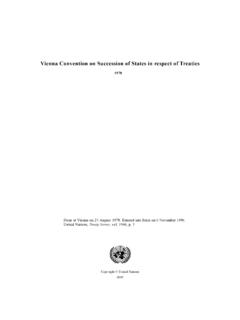Transcription of convention - unhcr.org
1 convention on the r e duct ion of stat e l e ssn e ss P ublished by : UNHCR. Box 2500. 1211 Geneva 2. Switzerland Text of the 1961 convention on the Reduction of Statelessness with an Introductory Note by the Office of the United Nations High Commissioner for Refugees 1961 c o n v e n t i o n reduction of statelessness 1. 2 1961 c o n v e n t i o n reduction of statelessness introductory note by the Office of the United Nations High Commissioner for Refugees (UNHCR). T he C onvention on the R eduction of S tatelessness was adopted on 30 August 1961 and entered into force on 13 December 1975.
2 It complements the 1954 convention relating to the Status of Stateless Persons and was the result of over a decade of international negotiations on how to avoid the incidence of statelessness. Together, these two treaties form the foundation of the international legal framework to address statelessness, a phenomenon which continues to adversely affect the lives of millions of people around the world. The 1961 convention is the leading international instrument that sets rules for the conferral and non-withdrawal of citizen- ship to prevent cases of statelessness from arising.
3 By setting out rules to limit the occurrence of statelessness, the convention gives effect to article 15. of the Universal Declaration of Human Rights which recognizes that every- one has the right to a nationality.. Underlying the 1961 convention is the notion that while States maintain the right to elaborate the content of their nationality laws, they must do so in compliance with international norms relating to nationality, including the principle that statelessness should be avoided. By adopting the 1961 Conven- tion safeguards that prevent statelessness, States contribute to the reduction of statelessness over time.
4 The convention seeks to balance the rights of individuals with the interests of States by setting out general rules for the prevention of statelessness, and simultaneously allowing some exceptions to those rules. The 1961 convention establishes safeguards against statelessness in several different contexts. A central focus of the convention is the prevention of statelessness at birth by requiring States to grant citizenship to children born on their territory, or born to their nationals abroad, who would otherwise be stateless.
5 To prevent statelessness in such cases, States may either grant 1961 c o n v e n t i o n reduction of statelessness 3. nationality to children automatically at birth or subsequently upon applica- tion. The convention further seeks to prevent statelessness later in life by pro- hibiting the withdrawal of citizenship from States' nationals either through loss, renunciation, or deprivation of nationality when doing so would result in statelessness. Finally, the convention instructs States to avoid statelessness in the context of transfer of territory.
6 For all of these scenarios, the 1961 Con- vention safeguards are triggered only where statelessness would otherwise arise and for individuals who have some link with a country. These stand- ards serve to avoid nationality problems which might arise between States. Pursuant to article 11 of the convention , in 1974 the United Nations General Assembly designated the Office of the United Nations High Commissioner for Refugees as the body to which individuals who claim the benefit of the convention may apply for examination of their claims and for assistance in presenting them to the relevant authorities.
7 (1) Subsequently, the General Assembly entrusted UNHCR with a global mandate to identify, prevent and reduce statelessness and protect stateless persons, specifically requesting that the Office provide relevant technical and advisory services pertaining to the preparation and implementation of nationality legislation. (2) The Execu- tive Committee of the High Commissioner's Programme has provided fur- ther guidance on the implementation of these responsibilities. Even in States which are not parties, the 1961 convention serves as a yardstick to identify gaps in nationality legislation, and is used by UNHCR as a basis for the tech- nical advice it provides to Governments.
8 The 1961 convention on the Reduction of Statelessness is of critical impor- tance today as statelessness persists in some protracted situations and con- tinues to arise in others. In light of the High Commissioner's call to eradicate statelessness by 2024, UNHCR is renewing its efforts to encourage States to accede to both statelessness treaties. (1) General Assembly Resolutions 3274 (XXIX) of 10 December 1974 and 31/36 of 30. November 1976. (2) General Assembly Resolution 50/152 of 21 December 1995.
9 4 1961 c o n v e n t i o n reduction of statelessness It is essential that the provisions of this convention be widely known and that all stakeholders engage in efforts to achieve an increase in the number of accessions to the convention , in order to address the plight of stateless persons around the world. Information on accessions to the 1961 convention on the Reduction of State- less Persons, the 1954 convention relating to the Status of Stateless Persons, as well as other relevant details, may be obtained from UNHCR, or from UNHCR's Refworld website at Geneva, May 2014.
10 1961 c o n v e n t i o n reduction of statelessness 5. convention on the Reduction of Statelessness The Contracting States, acting in pursuance of resolution 896 (IX), adopted by the General Assembly of the United Nations on 4 December 1954, considering it desirable to reduce statelessness by international agreement, have agreed as follows: 6 1961 c o n v e n t i o n reduction of statelessness Article 1. 1. A Contracting State shall grant its nationality to a person born in its terri- tory who would otherwise be stateless.










